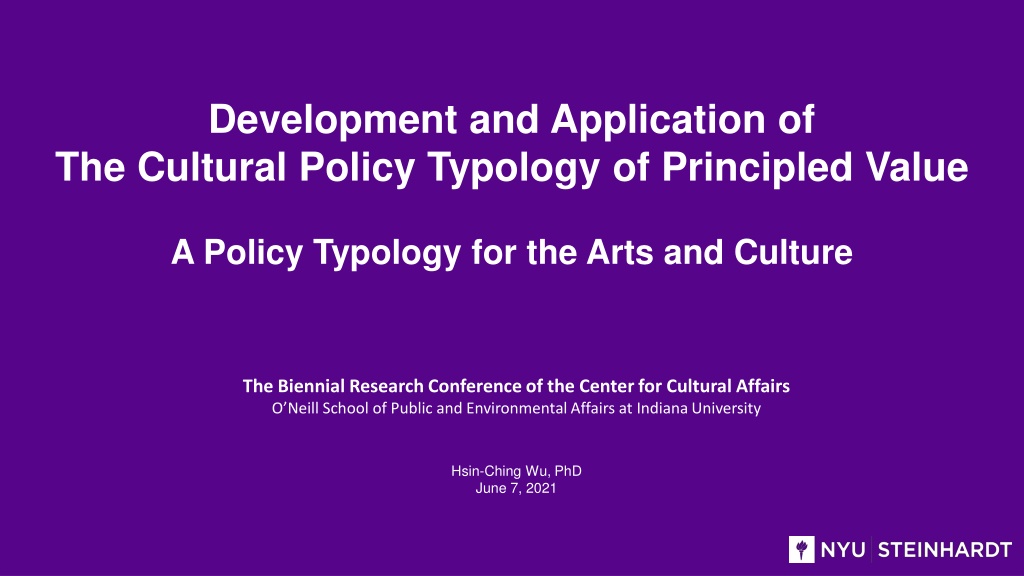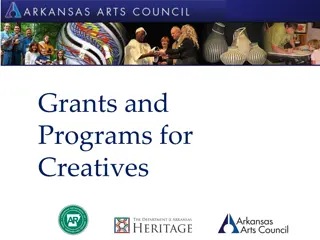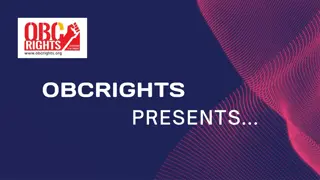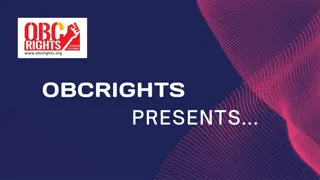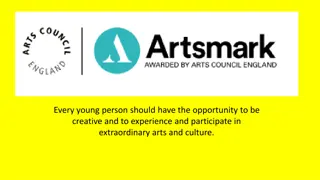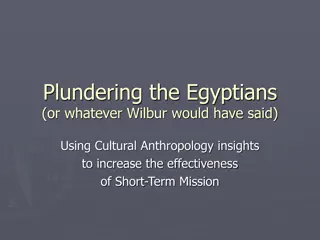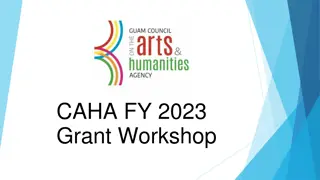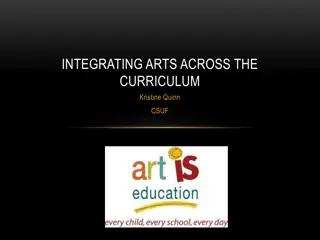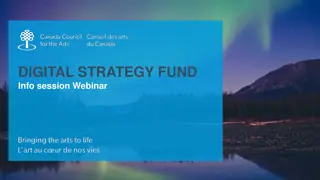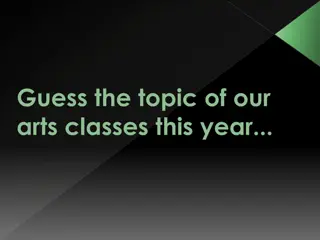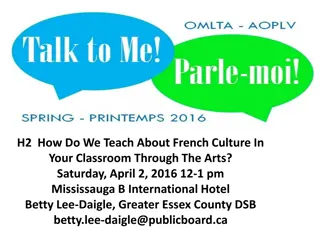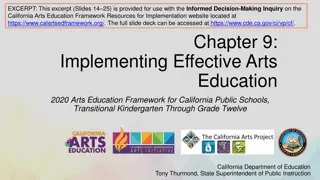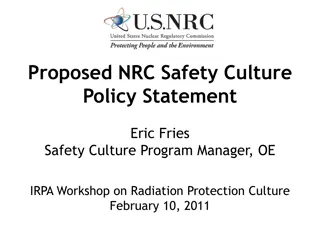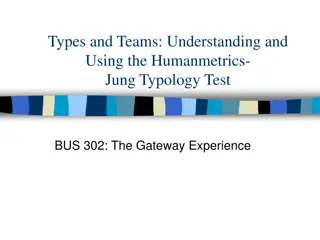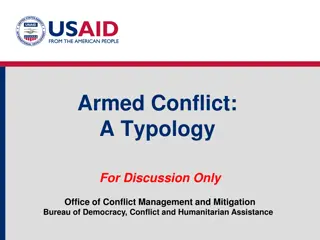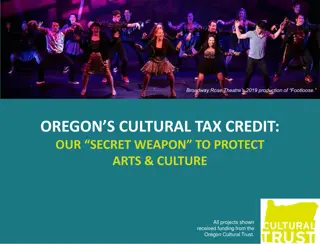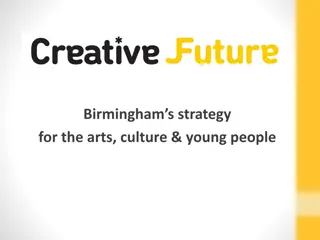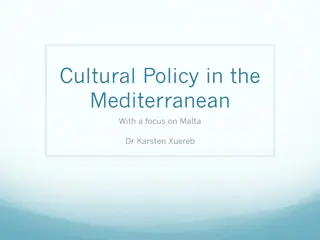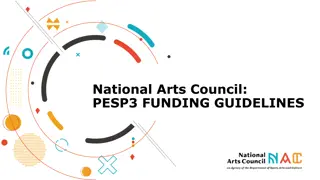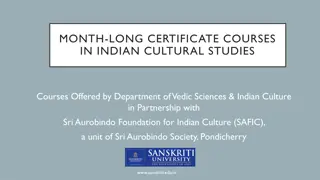Development and Application of Cultural Policy Typology for Arts and Culture
This research focuses on presenting a cultural policy typology based on goal variation and examining its application in a U.S. state art/cultural agency, specifically the Massachusetts Cultural Council. The study delves into the policy goals of the council and highlights the need for a specialized cultural policy typology to analyze governmental actions in the arts and culture sector effectively. The findings aim to contribute to understanding the public value and impact of arts and culture within society.
Download Presentation

Please find below an Image/Link to download the presentation.
The content on the website is provided AS IS for your information and personal use only. It may not be sold, licensed, or shared on other websites without obtaining consent from the author. Download presentation by click this link. If you encounter any issues during the download, it is possible that the publisher has removed the file from their server.
E N D
Presentation Transcript
Development and Application of The Cultural Policy Typology of Principled Value A Policy Typology for the Arts and Culture The Biennial Research Conference of the Center for Cultural Affairs O Neill School of Public and Environmental Affairs at Indiana University Hsin-Ching Wu, PhD June 7, 2021
Presentation Outline Background Literature Review Methods Findings Discussion and Conclusion
Background The significance of the arts and culture in society, and yet continuous debate on their public value Emerging interests in cultural policy in the U.S. Under the decentralized U.S. federal system, states and municipalities, as the sub-national units of the government, play a major part in the ecology of the cultural sector 3
Background: Research Aims Present a cultural policy typology based on goal variation Examine its unitization in a case of study of a U.S. state art/cultural agency, the Massachusetts Cultural Council 4
Research Question What are the policy goals of the Massachusetts Cultural Council? 9/26/2024 5
Literature Review Defining Governmental Actions in the Cultural Sector (Rentschler, 2002; Schuster et al., 2003) Public Values of the Arts and Culture (DiMaggio, 1987; United Nations) Economic Development Argument (Markusen & Schrock, 2006; Sterngold, 2004 ) Arts and Culture as Substantiable Development (UNESCO; Markusen & Gadwa, 2010) 6
Literature Review (continued) The Need for a Specialized Cultural Policy Typology Existing models of public policy typology (Lowi, 1964, 1972; Kellow, 1998; Wilson, cited in McCool, 1995, p. 246) are not sufficient or appropriate for analyzing the varying usage of culture McCarthy et al. (2004) developed a framework to help understand the benefits of the arts by classifying them for individuals and communities Research has been limited in terms of a specific typology that can be used to classify the governmental action in the arts and culture 7
Methods As part of a larger study conducted between 2015-2017 Interviews with 15 individuals 9 individuals were further asked to score the MCC s overall objectives using a 10-point scale in accordance with the presented typology Interviews were coded to identify common, unexpected, and unusual categories/themes 9/26/2024 8
Methods (continued) Case selection Massachusetts has a sizable cultural sector Cultural Organizations (2015) Population (2010) Cultural Organizations per 100,000 population Land Areas (square miles) Cultural Organizations per 1,000 square miles State Arizona Indiana Massachusetts Tennessee Washington Total Source: National Center for Charitable Statistics (2015); (Census 2010; n.d.) 592 764 1,924 618 1,105 44,663 308,745,538 6392017 6483802 6547629 6346105 6724540 9.26 11.78 29.38 9.74 16.43 14.47 113,594 35,826 7,800 41,235 66,456 3,531,905 5 21 247 15 17 12.66 9
Findings Types of Grant Programs Defined by the Cultural Policy Typology of Principled Value Grant Program Name Policy Goal Nature of Grants Grantee Cultural Policy Typology Competitive Instrumentality-neoliberal approach Economic development Organizations (project-based partnership, including municipalities) Adams Arts Program (since cancelled in 2017) Artistic quality Competitive Individuals Artist Fellowships Culture-centered public approach Education First-come-first-reviewed Schools Big Yellow School Bus Instrumentality-public approach Competitive Cultural Facilities Fund (CFF) Instrumentality-neoliberal approach Economic development Organizations (including municipalities and higher education institutions) Formula based Cultural Investment Portfolio (CIP) Operating support Organizations (including higher education institutions) Mixed: Instrumentality-neoliberal approach Instrumentality-public approach Culture-centered public approach n/a n/a n/a n/a Festivals Program* Formula based Local councils Local Cultural Council (LCC) Program Culture-centered public approach Local arts & culture Competitive Organizations or schools SerHacer Instrumentality-public approach Youth development Education First-come-first-reviewed Schools STARS Residencies Instrumentality-public approach Heritage Competitive Individuals Traditional Arts Apprenticeships Culture-centered public approach Competitive Organizations YouthReach Instrumentality-public approach Youth development 11
Findings (continued) Policy Orientations of the MCC 12
Discussion The MCC s policy goals are rather broadly defined The MCC was gradually moving away from instrumentality- neoliberalism This policy shift may be a natural progression in the field as scholars have become more critical of the neoliberal policy of the government (McLean, 2014; Tochterman, 2012; Zimmerman, 2008) The typology could be a very useful tool to help organizations to communicate their worth to public and private funders, the public, and other stakeholders in the community 13
Conclusion The MCC s policies could be categorized into the instrumentality- neoliberal, the instrumentality-public, and the culture-centered public approaches The Cultural Policy Typology of Principled Value can help advance the knowledge of cultural policy decision making at all governmental levels 14
Thank You! hw2918@nyu.edu hsinching.wu@gmail.com Scan to view my LinkedIn profile
References DiMaggio, P. (1987). Can culture survive the marketplace? In P. DiMaggio (Ed.), Nonprofit enterprise in the arts: Studies in mission and constraint (pp. 67-92). Cary, NC: Oxford University Press. Kellow, A. (1988). Promoting elegance in policy theory: Simplifying Lowi s arenas of power. Policy Studies Journal, 16 (summer), 713-723. https://doi.org/10.1111/j.1541- 0072.1988.tb00680.x Lowi, T. (1964). American business, public policy, case studies, and political theory. World Politics, 16, 687-691. https://doi.org/10.2307/2009452 Lowi, T. (1972). Four systems of policy, politics, and choice. Public Administration Review, 33, 298-310. http://doi.org/10.2307/974990 Markusen, A. & Gadwa, A. (2010). Creative placemaking: Executive summary. Washington, DC: National Endowment for the Art. Retrieved from https://www.arts.gov/sites/default/files/CreativePlacemaking-Paper.pdf Markusen A. & Schrock, G. (2006). The artistic dividend: Urban artistic specialization and economic development implications. Urban Studies, 43 (10), 1661-1686. https://doi.org/10.1080/00420980600888478 McCool, D. (1995). Discussion. In D. McCool (Ed.), Public policy theories, models, and concepts (pp. 244-250). Upper Saddle River, NJ: Prentice-Hill. McCarthy, K. F., Ondaatje, E. H., Zakaras, L., & Brooks, A. (2004). Gift of the muse: Reframing the debate about the benefits of the arts. Santa Monica, CA: RAND. Rentschler, R. (2002). The Entrepreneurial arts leader: Cultural policy, change and reinvention. Brisbane: University of Queensland Press Schuster, J., Karraker D., Bonaiuto, S., Grogan, C., Rothfield, L., & Smith, S. R. (2003). Mapping state cultural policy: The state of Washington. Chicago, IL: Cultural Policy Center at the University of Chicago. Sterngold, A. (2004). Do economic impact studies misrepresent the benefits of arts and cultural organizations. Journal of Arts management, Law, and Society, 34 (3), 166- 187. https://doi.org/10.3200/JAML.34.3.166-187 United Nations Educational, Scientific and Cultural Organization. (2001). UNESCO Universal declaration on cultural diversity. Retrieve from http://portal.unesco.org/en/ev.php-URL_ID=13179&URL_DO=DO_TOPIC&URL_SECTION=201.html United Nations Development Programmes. (1994). Human development report 1994. New York: Oxford University Press. Retrieved from
